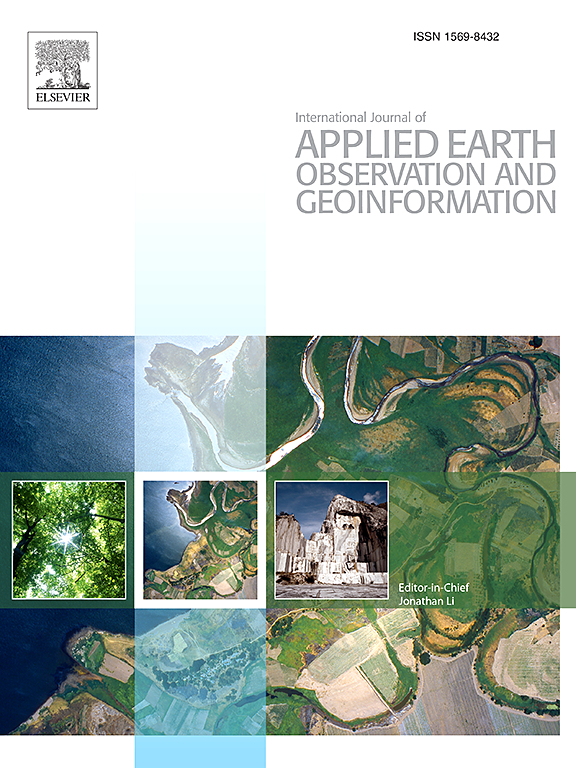Quantifying key indicators of essential biodiversity variables for mangrove species in response to hydro-meteorological factors
IF 7.6
Q1 REMOTE SENSING
International journal of applied earth observation and geoinformation : ITC journal
Pub Date : 2025-04-17
DOI:10.1016/j.jag.2025.104535
引用次数: 0
Abstract
Mangroves are critical for climate mitigation and biodiversity conservation, yet their spatiotemporal dynamics and physiological responses to hydrometeorological drivers remain poorly understood. This study extracted three essential biodiversity variables (area distribution, phenology, and physiological traits) and further revealed their dependencies on hydrometeorological conditions. We developed a continuous time-series monitoring method (CTSM) to enhance the Detect-Monitor-Predict detection framework for accurately tracking mangrove spatial succession in the Beibu Gulf from 2000 to 2021. We combined Continuous Change Detection and Classification with Harmonic Analysis of Time Series (HANTS) methods to capture the seasonal changes of physiological traits of dominant mangrove species. This study utilized HANTS-PLSR (partial least squares regression) response models and structural equation models to explore the seasonal responses of physiological trait to hydro-meteorological factors. The results indicated that (1) the improved detect component delineated fine-scale expansion patterns of mangroves, with area-hydrometeorology coupling evolving from uncoordinated to highly coordination during 2000–2021. (2) The start, peak and end of the growing season for mangroves are in March-April, June-September and January-February of the following year, respectively. The mangroves in different regions exhibit relatively delayed growth periods. (3) Aegiceras corniculatum exhibited bimodal phenological trajectories, contrasting with unimodal patterns in three co-occurring species. (4) The physiological traits displayed a positive correlation with water/air temperature and sunshine duration. The phenological changes of four mangrove species are driven by the interaction between hydrological and meteorological variables, with meteorological factors dominating (path coefficient > 0.50, p < 0.001). The findings provide insights into mangrove conservation and biodiversity monitoring.
水文气象因子对红树林生物多样性关键指标的响应
红树林对于减缓气候变化和保护生物多样性至关重要,但人们对其时空动态和对水文气象驱动因素的生理反应知之甚少。本研究提取了生物多样性的三个基本变量(面积分布、物候和生理性状),并进一步揭示了它们对水文气象条件的依赖关系。为完善2000 - 2021年北部湾红树林空间演替的Detect-Monitor-Predict检测框架,建立了一种连续时间序列监测方法(CTSM)。将连续变化检测与分类与时间序列谐波分析(HANTS)方法相结合,捕捉红树林优势种生理性状的季节变化。利用汉斯- plsr(偏最小二乘回归)响应模型和结构方程模型探讨了生理性状对水文气象因子的季节响应。结果表明:(1)改进的探测分量描绘了2000-2021年红树林的精细尺度扩展格局,区域-水文气象耦合从不协调向高度协调演变。(2)红树林生长季节的开始、高峰和结束分别为次年的3 - 4月、6 - 9月和1 - 2月。不同地区红树林的生长期相对较晚。(3)与3个共发生种的单峰物候模式相比,盾叶蝉的物候轨迹呈现双峰模式。(4)各生理性状与水/空气温度和日照时数呈正相关。4种红树林物候变化受水文和气象因子的共同作用驱动,气象因子占主导地位(路径系数>;0.50, p <;0.001)。这些发现为红树林保护和生物多样性监测提供了见解。
本文章由计算机程序翻译,如有差异,请以英文原文为准。
求助全文
约1分钟内获得全文
求助全文
来源期刊

International journal of applied earth observation and geoinformation : ITC journal
Global and Planetary Change, Management, Monitoring, Policy and Law, Earth-Surface Processes, Computers in Earth Sciences
CiteScore
12.00
自引率
0.00%
发文量
0
审稿时长
77 days
期刊介绍:
The International Journal of Applied Earth Observation and Geoinformation publishes original papers that utilize earth observation data for natural resource and environmental inventory and management. These data primarily originate from remote sensing platforms, including satellites and aircraft, supplemented by surface and subsurface measurements. Addressing natural resources such as forests, agricultural land, soils, and water, as well as environmental concerns like biodiversity, land degradation, and hazards, the journal explores conceptual and data-driven approaches. It covers geoinformation themes like capturing, databasing, visualization, interpretation, data quality, and spatial uncertainty.
 求助内容:
求助内容: 应助结果提醒方式:
应助结果提醒方式:


